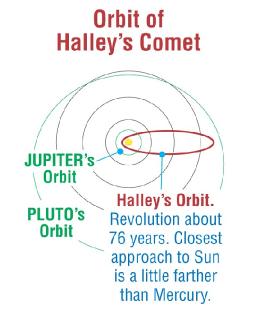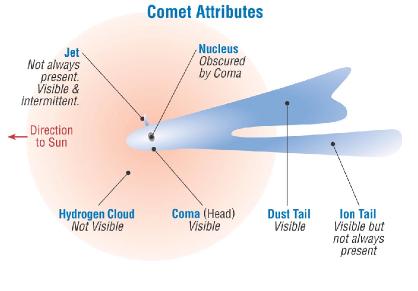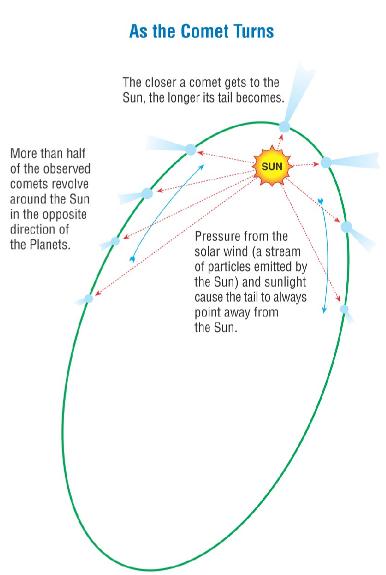 |
|
|
|
||
 |
||
Facts about Comets Bright comets are like unexpected gifts — we remember them with a special fondness.
How to observe comets: When a bright comet graces our skies, all you need are your eyes! Dark nights, without the Moon are best and getting away from city lights helps, too. Comets that are farther away and fainter may be viewed with binoculars or a telescope but the most spectular comets are the ones you can plainly see with your eyes. For a bright comet coming our way but not quite visible to the naked eyes, binoculars can help spot it. Now, remember, comets are usually large and can span a great portion of the sky.
Right. The Great Comet of 1997, Comet Hale-Bopp with its two tails. The blue tail is the ion tail and the whitish the dust tail. |
 |
|||
COMETS Comets are spectacular to behold. They span the sky in a splendor unequaled by any other celestial object. But what I really like about comets is that they bring astronomy to continents of people — in a grand display that unites us in the awe of the Universe. In earlier times, comets were harbingers of the future. Something as impressive as the unexpected appearance of a comet in the sky had to be significant! Depending on the culture, a comet represented either a good or bad omen. Today, we can enjoy comets as neither good nor bad but as the spectacular objects they are. It is good fortune when we get the opportunity to view one of these marvelous treasures.
Famous Comets to Grace our Skies The really great comets appear less often than we might like. Here are the best since 1682. 1682. Comet Halley. Named after the English astronomer Edmond Halley (1656–1742) who concluded that this was the same comet that appeared in 1531 and 1607. Comet Halley returns about every 76 years. Its regularity along with its brightness have made it the most familiar comet in the Solar System. During its 1986 appearance, six research spacecraft were sent out to learn more about it. 1744. Comet Chéseaux. Spectacular six-tailed comet. 1769. Comet Messier. The brightest comet discovered by the “Comet Ferret” and the year Napoleon was born. 1843. Great March Comet. Longest recorded tail. 1882. Great September Comet. Visible during the daytime. 1910. Comet Halley. Spectacular return display. Not all returns of Halley’s comet are spectacular. 1976. Comet West. Really nice but never got much publicity. 1993. Comet Shoemaker-Levy 9. Discovered the night of March 23, 1993, by Gene and Carolyn Shoemaker and David Levy from photographs taken at the Palomar Observatory complex in California. On July 16, 1994, this comet, which had broken into 21 fragments, rained down on Jupiter for a week. The impacts disrupted Jupiter’s clouds for almost a year, and the initial scars were visible in small telescopes. This collision was the most spectacular astronomical event of the twentieth century. 1995. Comet Hale-Bopp. A very beautiful comet. 1996. Comet Hyakutake. This comet took astronomers by surprise because they were in the midst of observing and investigating Hale-Bopp.
Origin and Orbits of Comets Comets are leftover aggregate from the formation of our Solar System. They represent matter that did not condense into the Sun, Planets or moons. They circle the Sun in very elongated, elliptical orbits with revolution periods ranging from just a few years to tens of thousands of years. Some of their orbits reach halfway to our nearest star, Proxima Centauri, four light years away. There are three major groupings of comets. Based on their orbits, they are named the Jupiter family, the Kuiper belt and the Oort cloud. The Jupiter family contains a small number of comets with orbits that reach a little farther than Jupiter’s and revolve around the Sun in as little as 32 years (Comet Encke is the most well known). Jupiter’s strong gravity has created this family by “roping in” longer period comets. The Kuiper belt comets reside in a region that extends from beyond Neptune to about 1,000 astronomical units. These short-er period comets have revolution periods of around 200 years. Most comets have long orbital periods in the thousands of years. Their orbits take them to the outer reaches of our Solar System, into the Oort cloud. They can reach distances of 20,000 to 100,000 astronomical units (1.6 light years) from the Sun. The Oort cloud is a roughly spherical area that surrounds the Sun and contains the bulk of the comets, estimated at a few trillion.
The Size and and Composition of Comets The nuclei of comets, that is, their solid bodies, vary in size. Diameters range from just a few to perhaps 150 miles. Comet Halley’s nucleus is the only one ever imaged. It resembles a potato in shape and measures approximately 9.5 by 6 miles. Comet Hale-Bopp’s nucleus is estimated to be 37 miles in diameter, which is considered a large comet. The often used phrase “dirty snowball” aptly describes a comet’s composition. Comets are a mixture of various ices, called ice volatiles (frozen water, ammonia, methane and other chemicals) and dust (sand-size silicate particles — the basic mineral of rocks). As a comet approaches the Sun and heats up, the ice volatiles in the nucleus sublime, that is, they change directly from solids to gases, to become the coma and tail. A new comet would be considered an asteroid until it develops a coma or tail. The coma can have a diameter of 125,000 to 1.2 million miles and always obscures the small nucleus. Comas start to develop at a distance around three astronomical units (between Mars and Jupiter), the tails a little farther out. In 1970, it was discovered that an invisible, tenuous hydrogen cloud extends from the coma, with a diameter in the range of millions of miles. Comet tails can stretch for millions of miles; the longest being around 12 astronomical units. The solar wind and pressure from sunlight push the tail away from the Sun. Often, comets develop two tails: a yellowish-white dust tail and a blue ion tail (blue from fluorescing ions). Either one or both tails may be present. A comet may exhibit a jet or jets, which are spurious eruptions that shoot out from the nucleus. They develop when pockets of ice volatiles are exposed. A jet can turn on and off, depending on the rotation of the nucleus and exposure to the Sun.
A Comet’s Legacy: Meteor Showers The annual meteor showers are compliments of comets. Showers occur when the Earth passes through the wakes of comets, containing sand-size silicate particles (see Meteor Showers).
When will the next comet appear? Astronomers cannot predict when bright, visible comets will appear. Most comets come from the outer regions of our Solar System and do not become noticeable until they get close to the Sun. They wait for individuals like David Levy to gaze up and discover them so they can be announced to the world. Unexpected gifts are often remembered the most, and so it is with comets. These unexpected and marvelous guests leave us with the fondest memories.
Observing Comets When a bright comet is in the sky, everyone starts looking up. Whether you are out in a parking lot or in your backyard, you will see eyes gazing upward to glimpse the splendor in the heavens. The naked eye, binoculars and telescopes at low magnifications can be used to observe the large visible comets. Binoculars mounted on a tripod are a good observing combination. Binocu-lars will enable you to see most or all of a comet in the same field of view while the tripod will help steady the binoculars and allow easy extended viewing. Although the bright and highly visible comets are what we long for, unfortunately, they appear too infrequently. However, every year, a few new comets are usually discovered but they are too faint to be seen with the naked eye. They can only be viewed with telescopes. Their paths and magnitudes are often posted on the internet. |
 |
||||||
 |
|||||||
 |
|||||||
What’s Out Tonight? is sponsored by Ken Press, publisher of astronomy books and charts. |
||